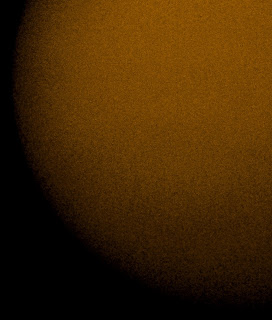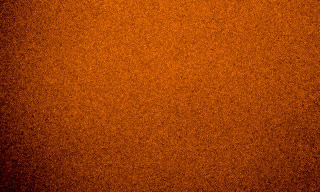Oct 30th 1130 GMT
At last, the Sun arose from the mists of morning. I took
some full disc and close-up shots of the Sun in hydrogen alpha light with my
PST.
Oct 29th 2120 GMT
I
moved the camera to aim at Auriga. I stacked 160 images to capture the constellation.
Oct 29th 2020 GMT
I
aimed my DSLR at the polar regions at 18mm focal length, ISO 6400 and 6 seconds
exposure. Except I didn't set the focal length to 18mm but 55 instead. This reduced the field of view so meteor detection was almost impossible. Still, I managed to stack 255 frames in Microsoft ICE to get this image.
Oct 29th 1900 GMT
Following a suggestion on the East Midlands Stargazers board, I tried using ISO 100 and 1/400 second exposure on the Moon with my Mak and DSLR at 1.54m focal length. I stacked 200 frames.
October 29th 1300 GMT
Oct 28th 1110 GMT
I checked the Sun with my PST under hazy conditions. It was quite band, so I took full disc shots only.
Oct 27th 2200 GMT
While my camera was snapping away, I had a look round the
sky in my binoculars. Although I could see parts of the Milky Way, it was
rather hazy. With Taurus clear of the horizon, the obvious targets were the
Pleiades (M45) and Hyades. I could only see about 20 Pleaides, although the
Hyades showed well, as usual. Melotte 20, being bright and loose, like the
Hyades, showed well but the Perseus Double Cluster and M34 were barely visible.
The Andromeda Galaxy (M31) was high but quite faint. I checked out Albireo and
the Coathanger before finishing.
Oct 27th 2010 GMT
At 2045 GMT, I caught a firework by Perseus.
I stacked 250 images using Microsoft ICE to get this message of Perseus.
Oct 27th 1955 GMT
I
did a shoot of the Moon with my Mak and DSLR. I used 1540mm focal length, ISO
400 and 1/1600 second exposure.
October 27th 0900 GMT
I checked the Sun with my PST. It appeared quite bland but there seemed to be some features near the bottom limb that was blinking in and out of view. I took some full disc frames plus some selected close-ups.
October 25th 0930 GMT
I
checked the Sun in hydrogen alpha light. I could not see the sunspot. Although
the solar disc was fairly quiet, there seemed to be some minor activity around
the solar limb. I took close-up and quadrant frames.
October 25th 0845 GMT
Oct 25th 0625 GMT
Before leaving home, I bin scanned Venus in the dawn sky.
Its apparent size was very small and I could not differentiate its phase from a
full disc.
Oct 23rd 1020 GMT
I saw a small sunspot on the Big Bear images but I was not able to see it with my binoculars.
Oct 21st 0920 GMT
I checked the Sun in hazy conditions in hydrogen alpha light
with my PST. I could not see any features, so just took full disc shots.
Oct 20th 0950 GMT
The Sun appeared through a gap in the clouds, so I managed
to take one full disc shot with my PST before cloud rolled in again.
Unfortunately, my only image caught cloud and I could not be sure whether any "features" were real.
Oct 17th 0755 GMT
The Sun was low down and in haze. I checked it with my PST
but the image was faint. I took full disc images only.
Oct 17th 0630
I
took a few frames of the waning crescent moon with my DSLR at 300mm focal
length, 1/4000 second exposure and ISO 800.
Oct 16th 1940 GMT
The
storm called Ophelia was grabbing the headlines but there were some clear
patches. To go with the Pegasus shots I took, I used the same settings as usual
and aimed at Andromeda. Unfortunately, Deep Sky Stacker produced the dreaded vertical lines, so I stacked 16 images using Microsoft ICE.
I moved to Aquila. Unfortunately, the lens had misted and really needed a clean. I stacked 11 light frames and 18 dark frames but cropped out Aquila, Dephinus and Vulpecula as separate images.
October 16th 1405 GMT
After a cloudy and hazy morning, thin cloud was moving
across the Sun in the afternoon. I tried my luck with my PST and took full disc
and close-up frames.
Oct 15th 1515 GMT
It
finally cleared in the afternoon but the Sun was already low down. I checked
the Sun with my PST but I could not see any detail and the image was faint. I
took some full disc shots only.
October 14th 1950 GMT
I
set a camera aimed to the north of Pegasus at 18mm focal length, 30 seconds
exposure and ISO 800.
I caught a sporadic meteor at 2004 GMT.
I aimed the camera at Aquila but did not get anything, due to cloud.
October 12th 2045 GMT
I took a few darks then set my camera at 18mm focal length,
ISO 800 and 30 seconds exposure and aimed it at the north polar regions. I took 4 dark frames and used 9 light frames (later ones being clouded out). I cropped out a lot of skyglow and ended up with Cassiopeia, with the Perseus Double Cluster to the bottom right.
October 11th 2015 GMT
I left a camera out aimed at Draco in the unlikely hope of
catching a Draconid meteor. My settings were ISO 6400, 18mm focal length and 2
seconds exposure.
I didn't catch so much as an aircraft trail but I stacked 399 images 50 at a time (49 on the last one) and stacked the eight stacks. I ended up with most of Draco and Ursa Minor.
Oct 7th 1520 GMT
I
had another look at the Sun through my Coronado PST. Although the solar disc
was bland, I saw some shading but still considered the level of activity too
low to take close-ups. I caught my first prominence for ages, though!
October 7th 0930 GMT
I checked the Sun in hydrogen alpha light with my PST. The solar disc looked bland, so just took some full disc shots.
October 6th 1115 GMT
I
checked the Sun with my Mak and DSLR at 1540mm focal length, ISO 400 and 1/4000
second exposure.
Oct 6th 0815 GMT
I checked the Sun in hydrogen alpha light with my PST. The
solar disc was bland, apart from the sunspot was about to rotate off. I took
some full disc frames plus some close-ups of the region surrounding the
sunspot.
October 5th 2010 GMT
The Moon was full and I went out with my DSLR and Mak. I took 124 frames at 1540mm focal length, ISO 400 and 1/4000 second exposure.
October 5th 1210 GMT
I bin scanned the Sun in a clear sky and could only see one
large sunspot.
Oct 2nd 1950 GMT
There was a lot of cloud around but some clear patches to
the north. I set up my DSLR and intervalometer to take multiple exposures to
the north east at ISO 800 18mm focal length and 40 seconds exposure. I stacked 33 images to catch Perseus rising and the surrounding constellations.
Oct 2nd 1950 GMT
There
was a lot of cloud around but some clear patches to the north. I set up my DSLR
and intervalometer to take multiple exposures to the north east at ISO 800 18mm
focal length and 40 seconds exposure.



























































